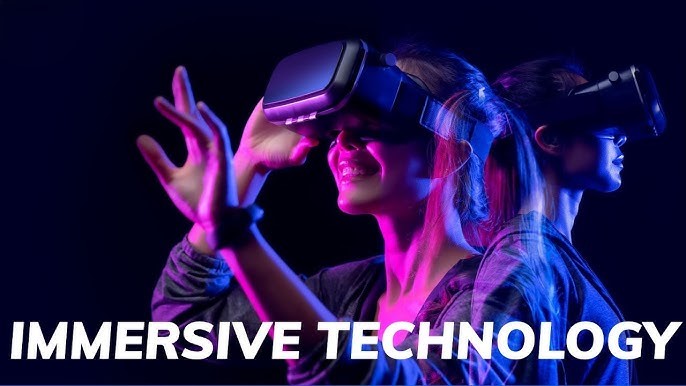Introduction In recent years, immersive technology has taken the entertainment world by storm. Virtual reality (VR), augmented reality (AR), and mixed reality (MR) are reshaping how we experience movies, gaming, music, and live events. These technologies are not just enhancing entertainment; they are revolutionizing it by allowing users to engage with media in a way
Introduction
In recent years, immersive technology has taken the entertainment world by storm. Virtual reality (VR), augmented reality (AR), and mixed reality (MR) are reshaping how we experience movies, gaming, music, and live events. These technologies are not just enhancing entertainment; they are revolutionizing it by allowing users to engage with media in a way that was once unimaginable.
As the digital world evolves, immersive technology is positioning itself as a key player in entertainment’s future. This article will explore how immersive technology is transforming entertainment, the current trends, challenges, and future possibilities.
What is Immersive Technology?

Image by: Yandex.com
Immersive technology refers to technologies that allow users to experience and interact with a computer-generated environment in a way that feels real. These technologies use advanced hardware and software to create environments or experiences that can engage the user’s senses.
The main types of immersive technology include:
- Virtual Reality (VR): VR creates a completely artificial environment where users can interact and explore.
- Augmented Reality (AR): AR overlays digital elements onto the real world, enhancing what the user sees.
- Mixed Reality (MR): MR combines both VR and AR, allowing digital and real-world elements to coexist and interact in real-time.
The Role of Immersive Technology in Shaping the Entertainment Industry

Image by freepik
Immersive technology is changing how people consume entertainment. In gaming, VR and AR are making experiences more realistic, while in movies and TV, these technologies allow viewers to interact with the storyline or even become part of it. In live events, immersive tech lets fans enjoy shows from home or adds interactive features to concerts and sports. Immersive technology is pushing the boundaries of what’s possible, giving fans new ways to experience their favorite entertainment.
VR and Movies: A New Way to Watch

Image by freepik
Movies are starting to be more interactive, thanks to immersive technology. With virtual reality (VR), viewers can step into a movie and experience it from the inside. Instead of just watching a screen, they can look around and explore the scene as if they were a part of it. This makes the movie experience more engaging. Augmented reality (AR) is also making waves in the movie world. It allows movie studios to create fun, interactive experiences that fans can enjoy on their phones or tablets. Imagine playing games or solving mysteries while watching your favorite movie characters come to life!
How Immersive Technology is Changing Entertainment

Image by: Yandex.com
Immersive technology is transforming entertainment in several significant ways. Below, we explore how VR, AR, and MR are making their mark.
1. Transforming Video Games
The gaming industry has been at the forefront of immersive technology. With VR headsets and motion-sensing controllers, players can now step inside their favorite games. This creates a more interactive and engaging experience compared to traditional gaming, where players simply control a character on a screen.
2. Revolutionizing Movies and Television
Immersive technology has the potential to completely change how we experience movies and TV shows. With VR headsets, viewers can be transported into the movie’s world, offering a fully immersive viewing experience. Instead of watching a film on a flat screen, users can look around and interact with the scene, making them feel like part of the story.
3. Enhancing Live Events and Concerts
Live events, including concerts, theater, and sports, are beginning to integrate immersive technology to enhance the audience’s experience. VR enables people to attend live performances remotely, offering the sensation of being there in person. AR, on the other hand, can be used to display real-time statistics or interactive elements, such as virtual performers joining a concert.
4. Changing Social Media Interactions
Platforms like Snapchat and Instagram have already incorporated AR features, allowing users to add filters or play interactive games. In the future, immersive technologies could make social media experiences even more interactive, offering users the chance to experience virtual worlds and events together.
Key Trends in Immersive Technology Entertainment

Image by: Yandex.com
As immersive technologies continue to develop, certain trends are becoming increasingly apparent in the entertainment industry:
1. Increased Use of VR Headsets
The market for VR headsets, such as the Oculus Quest and PlayStation VR, has grown significantly. These headsets are becoming more affordable and accessible, allowing more consumers to experience VR in their homes. With games, movies, and live events becoming more immersive, the demand for VR headsets is expected to continue rising.
2. The Emergence of 5G Technology
5G networks will enhance immersive technology by providing faster internet speeds and lower latency. This will improve VR and AR experiences, allowing for smoother, more realistic interactions. With 5G, users can access high-quality immersive content on their mobile devices, making VR and AR experiences more mobile-friendly.
3. Interactive Storytelling
Immersive technology is enabling new forms of storytelling, particularly in gaming and movies. Games like Half-Life: Alyx have shown that VR can tell compelling stories where the player’s actions influence the narrative. This form of interactive storytelling could soon extend to movies and TV shows, where viewers’ decisions could affect the plot’s outcome.
Challenges Facing Immersive Technology in Entertainment

Image by: Yandex.com
While the potential for immersive technology in entertainment is immense, there are several challenges that must be addressed before it can be fully realized.
1. High Costs
Currently, immersive technology, particularly VR headsets and the necessary equipment, can be expensive. This creates a barrier to entry for many potential users, limiting the widespread adoption of immersive entertainment. However, as technology advances, the costs are likely to decrease, making it more accessible to the general public.
2. Technical Limitations
Despite significant advances in technology, immersive experiences still have technical limitations. Issues such as motion sickness in VR, lack of content, and the need for high-powered hardware remain significant challenges. Developers are working on solutions, but it may take time before immersive technology reaches its full potential.
3. Content Creation and Development
The success of immersive entertainment relies heavily on high-quality content. Creating immersive experiences requires significant investment in both technology and creative talent. As more studios and developers get involved, the variety and quality of immersive content will likely increase, but content creation still remains a challenge.
Future Possibilities: What Lies Ahead?

Image by: Yandex.com
The future of immersive technology in entertainment is promising. We can expect to see more immersive content across various entertainment sectors, from gaming to live performances. As technology improves, experiences will become more realistic, interactive, and engaging.
The integration of AI and machine learning could also lead to more personalized immersive experiences, where content adapts to the user’s preferences and actions. The future may also see the rise of entirely new forms of entertainment that we can’t yet fully imagine.
Analysis of Immersive Technology in Entertainment
Below is a table analyzing the impact of immersive technology across various entertainment sectors:
| Sector | Technology Used | Key Benefits | Challenges |
|---|---|---|---|
| Video Games | VR, AR | Enhanced interaction, immersive environments | High cost of equipment, limited content |
| Movies/TV | VR, AR, MR | Immersive viewing, interactive storytelling | Expensive production, accessibility issues |
| Live Events | VR, AR | Remote attendance, interactive experiences | Requires advanced technology, high setup costs |
| Social Media | AR, MR | Engaging user interactions, creative content | Limited by current mobile capabilities |
Comparative Table: Traditional vs. Immersive Entertainment
This table compares traditional entertainment with immersive technology in terms of user engagement and experience:
| Feature | Traditional Entertainment | Immersive Entertainment |
|---|---|---|
| User Interaction | Passive (watching/reading/listening) | Active (engaging with content) |
| Experience Type | Limited to screens and audio | 3D environments, sensory engagement |
| Cost | Lower upfront costs | High initial costs, ongoing hardware needs |
| Access | Widely available (TV, theater, radio) | Requires specific technology (VR headsets, AR apps) |
| Content | Static, pre-recorded | Dynamic, interactive, and evolving |
Conclusion
Immersive technology is undoubtedly shaping the future of entertainment. By blending the digital and physical worlds, it creates new ways for audiences to engage with content. Whether in gaming, movies, concerts, or social media, immersive technologies are pushing the boundaries of what is possible. As the technology matures and becomes more accessible, it is likely to become an integral part of the entertainment landscape.
While challenges remain, such as cost, technical limitations, and content creation, the future of immersive entertainment looks incredibly bright. With continued advancements in VR, AR, and MR, we are on the cusp of an entertainment revolution that promises to change how we experience media forever.

















